Pulloxhill Church Alterations and Repairs
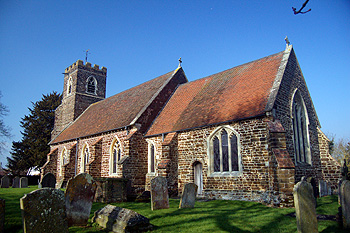
Pulloxhill church from the south-east March 2011
Most of the structural history of the church can be found in detail in Bedfordshire Historical Record Society Volume number 77 of 1998 Bedfordshire Churches in the Nineteenth Century: Part II: Parishes H to R put together by former County Archivist Chris Pickford from numerous sources some held by Bedfordshire & Luton Archives & Records Service and some held elsewhere or published.

The interior looking east June 2011
Today's church is, essentially, the work of James Tacy Wing who rebuilt the church in 1845 and 1846. Only the chancel remains from the medieval church but the rebuilding is in the same style and conforms to the same plan – chancel, nave, west tower.
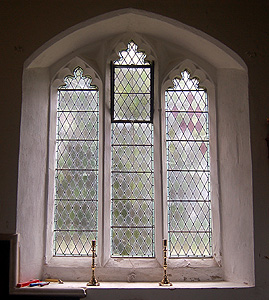
Window in the south wall of the chancel June 2011
In 1578 the archdeacon visited the church and reported that the chancel was in a state of decay. Incomplete churchwardens' accounts from 1612 to 1963 [P13/5/1-3] note that the church was painted in 1628 and 1629 [P13/5/1].
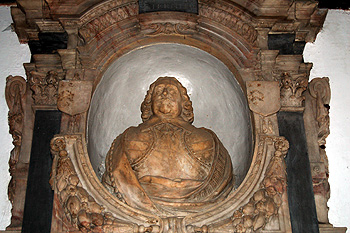
Detail from the monument to Sir William Bryers June 2011
In the 1650s a monument to William Briers, who died in 1653, was erected in the chancel. He was Lord of the Manor of Pulloxhill and Greenfield. The monument, with a fine bust, is in marble and was erected by Briers' second wife Arabella who mentions both herself and his first wife Anne. Anne, who died in 1631, has a brass and Arabella herself has a floor slab indicating that she died in 1662. Also in the chancel is a brass to George Fitz, Lord of Kitchen Manor, who died in 1608 and his wife Anne.
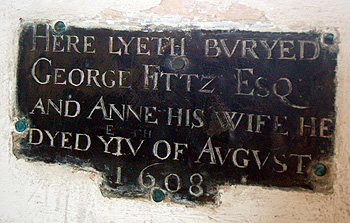
Brass to George Fitz in the south wall chancel June 2011
Around 1653, it is not known precisely when, the west tower collapsed, leaving only the west wall standing. The tower was left in this state until Wing's rebuilding nearly two hundred years later.
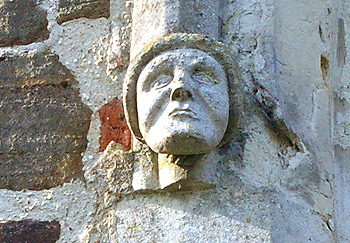
Head on the east side of the north nave east window March 2011
In 1665 the churchwardens bought five hundred tiles to repair the roof [P13/5/1]. £39 was spent on repairs in 1683. In 687 the churchwardens levied a special rate to repair the steeple and the bells [[ABF3/174] but the work was not carried out. In 1708 it was noted that the four bells were "lying in the south porch of the Church, all crack'd & ye clappers of all but one sold" [ABE2 volume II page 546]. Eventually in 1713 a faculty was obtained to sell the bells and use the money to erect a small belfry for two new bells and to "repair the Breach in the West end of the Church" [ABF3/175]. This small belfry was made in the surviving western fragment of the tower and only one bell was used.
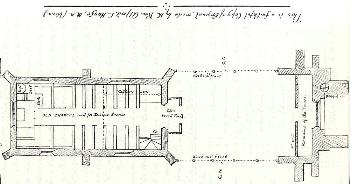
Plan of Pulloxhill church in 1845
It seems likely that by the mid 18th century the nave, too, was in a ruined state and had been abandoned. It seems likely that it was damaged when the tower fell and was never repaired. For just over a hundred years the only parts of the church to be used were the chancel and the repaired western part of the tower, presumably with a grassed over space between them. To see a larger version of the plan above, please click on the image.
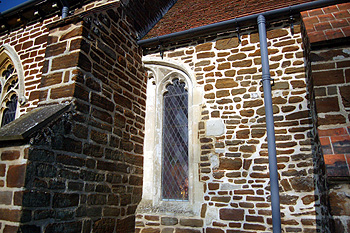
The west window in the south wall of the chancel March 2011
The cost of repairs to the church was now an eye-watering £1,083 but in 1739 the parishioners set about raising the money [QSR1740/103]. In the event less than £400 was raised and this was used to refurbish the chancel instead.
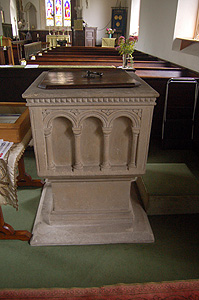
The font June 2011
Churchwardens' accounts reveal minor repairs in 1802 and 1803 and in 1810 and 1811 [P13/5/1]. A new font was purchased in 1830 [P13/5/2]. In 1836 the church plate was stolen. Archdeacon Bonney writing between 1822 and 1840 described the church as "the remnant of a ruin" whilst A. P. Boissier writing in 1827 stated: "the Tower and Chancel only remain of the original building … the nave is destroyed". In 1844 the parishioners stated: "The Church has been for a length of time insufficient for the population, we hope soon to have it in a better state" [ABCV131]. A plan made in 1845 shows that the west end of the chancel had a gallery over it and a simple open wood porch allowing admission at the west end.
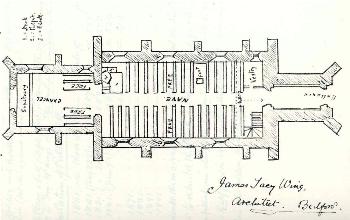
Pulloxhill church after restoration
When James Tacy Wing rebuilt the church in 1845 and 1846 he shortened the chancel and built a new nave and tower. Evidence for his shortening of the nave can be seen in the rather ham-fisted way that the western window in the chancel south wall has been cut in two and half obliterated by the new nave. The church reopened on 1st May 1846. The following year a new vicarage was built [X254/88/206-210]. To see a larger version of Wing's plan for the restored church above, please click on the image.

Head on the west side of the north nave east window March 2011
John Martin was the librarian at Woburn Abbey. During the 1840s and 50s he wrote regular articles on Bedfordshire churches for the Northampton Mercury. He was an opinionated man and his articles often lambast clergy and laity alike for the state of their church. His treatment of Pulloxhill, however, is much less strident: "This church has been almost entirely rebuilt, so we understood, by the liberality of the noble patron of the living [Thomas Philip, 2nd Earl de Grey], and the incumbent [Edward Lane Sayer]. The chancel, all that remains of the ancient structure, is in excellent condition, but it would have been better if the roof had been entirely of timber. No pew disfigures this quarter".
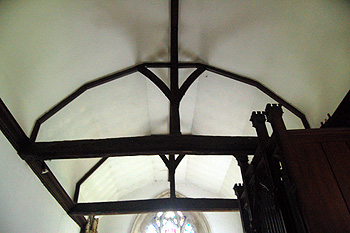
Beams in the roof of the chancel June 2011
"The sittings in the nave are all unenclosed, not a solitary private box to be seen; may it ever remain so. There is a gallery performing, as usual, its ill office of shutting out the western window. The tiles used for the floor are of a very humble description. The font, we are happy to say was made use of. The whole of the wooden fittings up were painted, to resemble oak; why not real oak? The entrance for visitors into the church was not by the chancel".
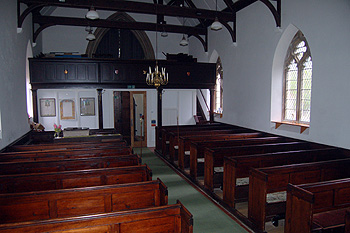
View from the pulpit June 2011
"We are happy to see the cross restored to its proper situation, both on the nave and chancel gable. When the puritanic horror of this sacred symbol is forgotten, we shall hope to see it again in the church-yard. Why we should "admit crosses on gables, head-stones, and monumental slabs, and reject the same symbol in its most appropriate place, where it may extend its arms over the graves of the departed till they cease to sleep, is altogether incomprehensible, because destitute of the semblance of consistent principle". We cordially adopt the words of one who has so successfully laboured in the great work of ecclesiastical restoration - "Crosses were erected in market places, not only to pay homage there, as elsewhere, to the Redeemer, but to inspire men with a sense of mortality and piety amidst the ordinary transactions of life. Why are they not permitted in consecrated ground, where the passer-by, as he approaches the church, might [find] holy thoughts awakened in his mind of the solemn service on which he is about to enter?"

Pulloxhill church from the east March 2011
"At present there is no resident clergyman, but this will ere long cease to be the case, as it was stated that an appropriate residence was about to be erected".
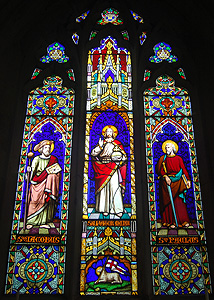
The east window June 2011
The chancel east window was filled with stained glass by Baillie in 1857 [P13/1/17] who also painted texts on the timbers of the chancel roof. The walls of the chancel were panelled in the late 1850s and new sanctuary chairs provided [P13/1/17].
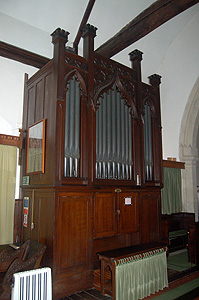
The organ June 2011
An organ, by Bevington, was installed in 1859 and a clock placed in the tower [P13/1/17]. New heating was provided in 1868 [P13/1/17]. Weatherboards in the belfry windows were renewed in 1879 [P13/5/2]. The organ was evidently unsatisfactory because in 1881 it was replaced by an instrument built by Heath and Reach organ builder Thomas Atterton [P13/1/17].
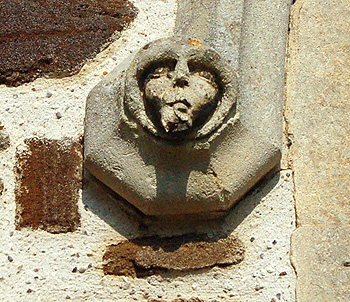
Head on the west side of the western south nave window March 2011
In 1881 the chancel was repaved in Minton tiles. In 1887 the windows in the church were re-glazed with cathedral glass to commemorate the Golden Jubilee of Queen Victoria - they cost £45/16/- [P13/1/17]. On 30th December 1893 The Bedfordshire Mercury reported that the church: "has recently undergone thorough repairs and considerable improvement".

The interior looking west June 2011
Some time before 1903 the communion table was presented as a gift by the tenant of The Grange, Mrs. Campion. The heating system was renewed in 1910 [P13/2/2/3]. In this year the vicar, Alfred Ernest Houfe began an incumbents' record book (a copy of which is on the searchroom shelves) detailing additions and alterations until 1965. The following are mentioned:
- 1907-1917: the roof was restored at a cost of £656/0/5;
- 1918: £24/4/- was paid for providing new fittings for the church's one bell.
- 1919: £12 was paid for completely overhauling the clock;
- 1922-1924: the whole of the interior and the tower was restored costing £364/13/9;
- 1964: the church was redecorated at a cost of £365;
In 1968 Rev. Burman designed and made new communion rails based on the design of the balusters at The Grange.
 Pulloxhill church from the south March 2011
Pulloxhill church from the south March 2011